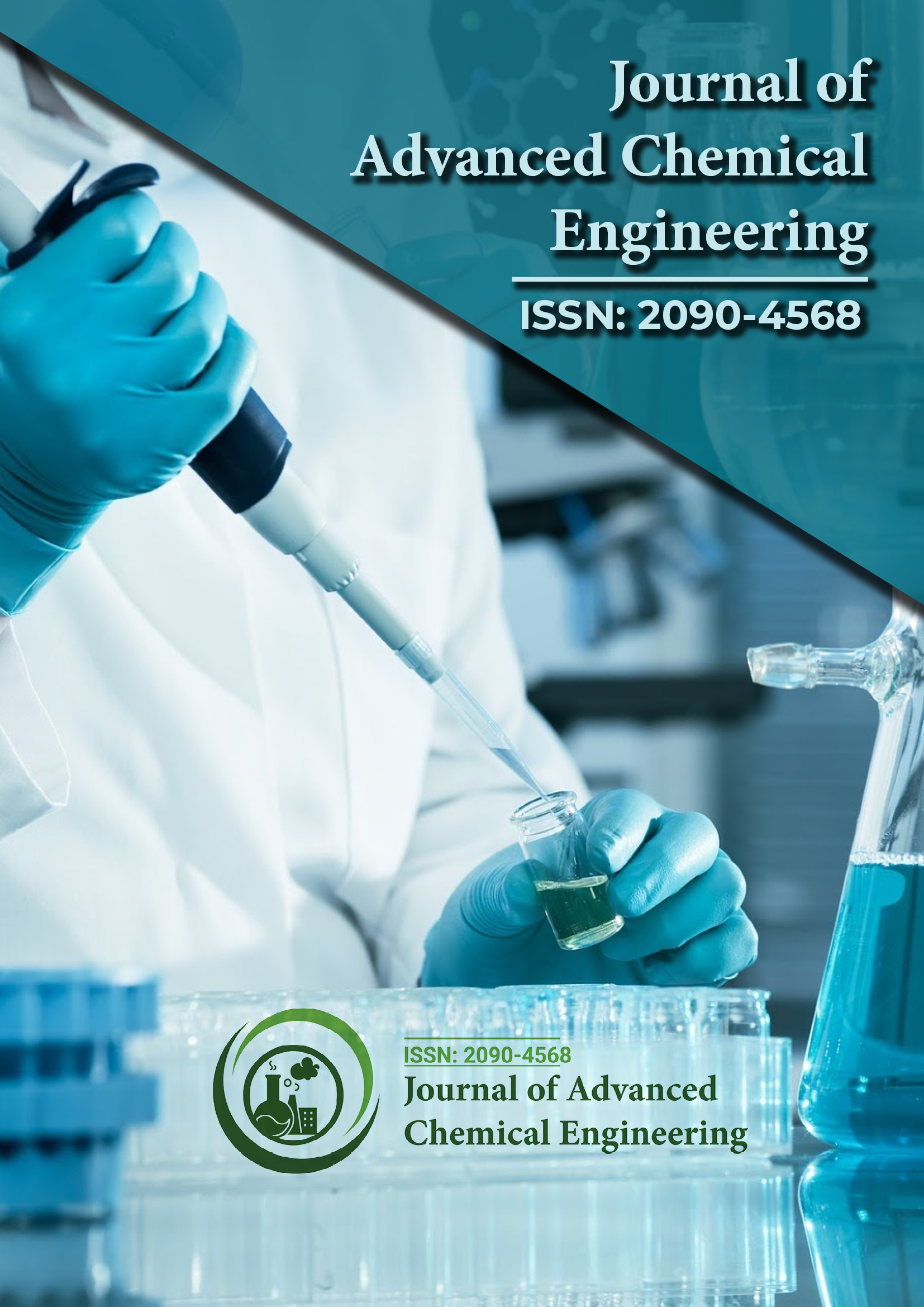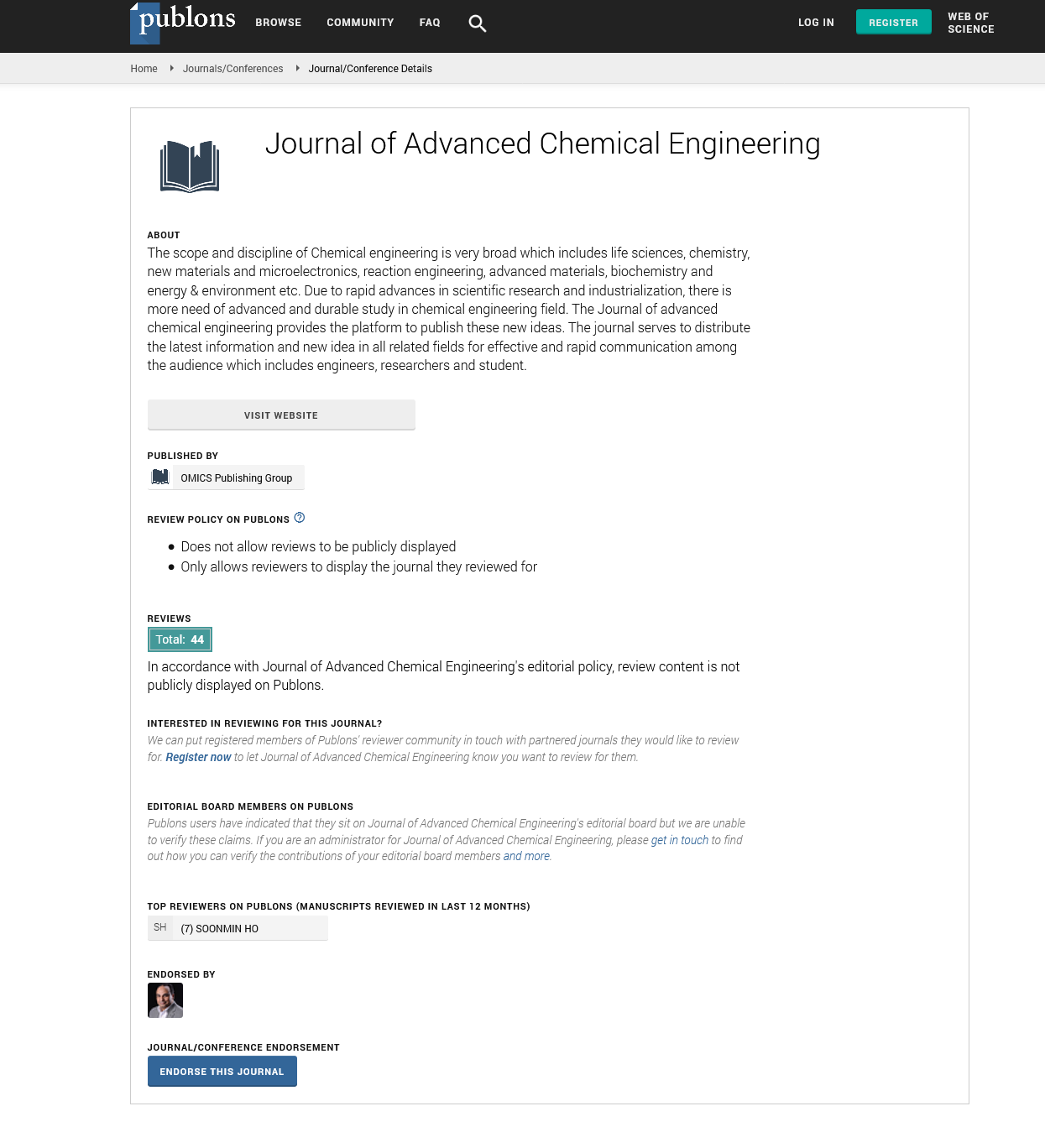Indexed In
- Open J Gate
- Genamics JournalSeek
- Smithers Rapra
- RefSeek
- Directory of Research Journal Indexing (DRJI)
- Hamdard University
- EBSCO A-Z
- OCLC- WorldCat
- Scholarsteer
- Publons
- Geneva Foundation for Medical Education and Research
- Google Scholar
Useful Links
Share This Page
Journal Flyer

Open Access Journals
- Agri and Aquaculture
- Biochemistry
- Bioinformatics & Systems Biology
- Business & Management
- Chemistry
- Clinical Sciences
- Engineering
- Food & Nutrition
- General Science
- Genetics & Molecular Biology
- Immunology & Microbiology
- Medical Sciences
- Neuroscience & Psychology
- Nursing & Health Care
- Pharmaceutical Sciences
Commentary - (2025) Volume 15, Issue 1
Nanostructured Membranes for Enhanced Gas Separation: A Paradigm Shift in Chemical Process Engineering
Emilia Novak*Received: 03-Mar-2025, Manuscript No. ACE-25-29151; Editor assigned: 05-Mar-2025, Pre QC No. ACE-25-29151 (PQ); Reviewed: 19-Mar-2025, QC No. ACE-25-29151; Revised: 26-Mar-2025, Manuscript No. ACE-25-29151 (R); Published: 02-Apr-2025, DOI: 10.35248/2090-4568.25.15.355
Description
Gas separation is a cornerstone operation in various industries including petrochemical refining, natural gas purification, air separation, and carbon capture. Traditionally, these processes have relied heavily on energy-intensive methods such as cryogenic distillation and pressure swing adsorption. However, membrane technology has emerged as a low-energy and scalable alternative. In recent years, the development of nanostructured membranes has introduced a revolutionary transformation in gas separation efficiency, selectivity, and operational robustness. The advent of nanomaterials has allowed for unprecedented control over the structure and chemistry of membrane surfaces. These enhancements result in membranes that exhibit selective permeation based on size, shape, or chemical affinity of the target gases. For instance, Carbon Nanotube (CNT)-based membranes exhibit ultrafast transport due to their atomically smooth inner surfaces and hydrophobic nature. By aligning CNTs vertically and embedding them in polymer matrices, researchers have created channels that allow for high flux without compromising selectivity.
Another groundbreaking advancement has been in the development of metal-organic frameworks (MOFs) for gas separation membranes. MOFs are crystalline materials composed of metal ions coordinated to organic ligands, forming porous structures with tunable properties. When used as fillers in Mixed- Matrix Membranes (MMMs), MOFs significantly enhance gas separation by acting as molecular sieves. MOF-polymer combinations such as ZIF-8 in polyimide have demonstrated exceptional performance in separating CO2 from CH4 and N2, critical in natural gas purification and carbon capture applications.
Graphene Oxide (GO)-based membranes also hold immense potential due to their single-atom thickness and tunable interlayer spacing. Functionalizing GO sheets with various groups enables selective permeability and enhances interaction with specific gas molecules. The lamellar structure of GO allows for layer-by-layer control, providing engineers with precise tools for designing application-specific membranes.
One of the major challenges in conventional polymeric membranes is the trade-off between permeability and selectivity, often referred to as the Robeson upper bound. Nanostructured membranes, through their engineered morphologies and functional groups, have shown promise in breaking this tradeoff. This opens new avenues for industrial gas separation systems that are both compact and energy-efficient.
Stability under operational conditions remains a key consideration for any membrane technology. Recent efforts have focused on improving the thermal, chemical, and mechanical stability of nanostructured membranes. Cross-linking techniques and hybrid structures combining inorganic fillers with robust polymers have led to membranes capable of withstanding extreme temperatures and corrosive environments.
Scale-up and manufacturability are vital for industrial adoption. Techniques such as electrospinning, interfacial polymerization, and layer-by-layer assembly are being optimized for mass production. Additionally, roll-to-roll fabrication methods are increasingly used to produce large-area membranes with consistent quality. Pilot plants employing nanostructured membranes are already in operation for oxygen enrichment and hydrogen recovery, showing promising techno-economic results.
The environmental footprint of membrane fabrication is another area receiving attention. The use of green solvents, biodegradable polymers, and recyclable nanomaterials is being integrated into membrane synthesis protocols. This aligns with broader sustainability goals and ensures that the shift towards nanostructured membranes does not inadvertently lead to environmental degradation.
Moreover, the integration of membrane systems with other separation processes is gaining momentum. Hybrid technologies, such as membrane-adsorption or membrane-distillation units, leverage the strengths of each method to achieve superior separation outcomes. These hybrid systems offer greater flexibility and adaptability in complex processing environments. Artificial intelligence and machine learning are also being applied to membrane design and optimization. Predictive models using molecular simulations and neural networks help identify optimal material combinations and processing parameters. This reduces experimental trial-and-error and accelerates the development cycle.
From an economic perspective, the reduction in operational costs and the compact footprint of membrane systems provide clear advantages over traditional methods. The modular nature of membrane units allows for easy integration into existing plants and flexible capacity expansion, making them ideal for both small-scale and large-scale applications. In conclusion, nanostructured membranes have significantly advanced the capabilities of gas separation technologies, offering solutions that are more efficient, sustainable, and adaptable. Continued research into new nanomaterials, improved fabrication methods, and system integration will ensure that this technology continues to evolve and find broader applications across the chemical engineering spectrum.
Citation: Novak E (2025). Nanostructured Membranes for Enhanced Gas Separation: A Paradigm Shift in Chemical Process Engineering. Adv Chem Eng. 15:355.
Copyright: © 2025 Novak E. This is an open-access article distributed under the terms of the Creative Commons Attribution License, which permits unrestricted use, distribution, and reproduction in any medium, provided the original author and source are credited.

